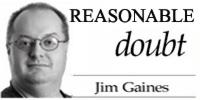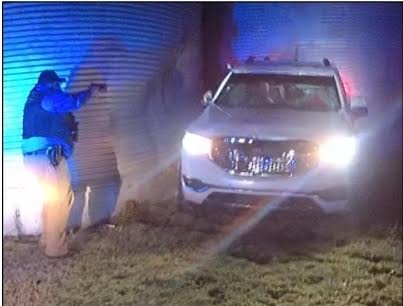Urban legends debunked
Published 12:00 am Sunday, January 29, 2006

- Urban legends debunked
“It’s true! I heard it from this guy … ”
Ah, urban legends. They’re hard to trace almost by definition, usually coming from a friend’s friend’s friend’s hairdresser’s mechanic’s cousin’s neighbor, and gaining in detail and asserted veracity with each leap.
Trending
And they keep getting passed: Dramatic enough to be interesting, yet plausible enough they might contain a grain of truth.
What I find truly remarkable about them, however, is their durability. The same story (or a close variant) may circulate for decades, being provisionally accepted as one of those things “everyone knows” or “everyone says” without anyone taking the time to look a little closer.
There’s quite enough of them about Bowling Green in circulation. Some invoke the supernatural, but those can wait. For now, let’s just look at a few of the easier ones to run down, and see if there is, in fact, a shadow of truth to a few of the most popular.
Story: Bowling Green has more restaurants per capita than any other U.S. city.
Austin, Dallas and Houston, Texas; Bethesda, Md.; Boulder and Fort Collins, Colo.; Columbus, Dayton and Toledo, Ohio; Destin, Fla.; Durham, N.C.; Ithaca, N.Y.; Knoxville, Tenn.; Omaha, Neb.; Pasadena and Santa Barbara, Calif.; Portland, Maine; Portland, Ore.; Purdue, Ind.; Santa Fe, N.M.; and Wilmington, Del.
All of the above are rumored to hold the same exclusive title as Bowling Green.
Trending
Closer to home, so is Lexington.
The most frequently mentioned contenders are Madison, Wis., and San Francisco – but little evidence is ever cited for any such claim, and it’s unlikely there’s a comprehensive national count that really exists.
There is a ranking based on economic census data for what appear to be the 100 largest U.S. cities, and that lists Boston as the leader, with one restaurant for every 465 people, said Annika Stensson, manager of media relations for the National Restaurant Association.
To meet the same restaurant-to-resident ratio as Boston, Bowling Green would need 108 restaurants, assuming our city-limits population of around 50,000.
Well, it’s clear Bowling Green eaters, whether permanent residents, college students or passers-by on Interstate 65, are no slouches. A quick thumb through the phone book turns up more than 150 dining establishments, counting multiple locations of chains like McDonald’s as separate restaurants. That works out to a restaurant for every 333 people.
According to David Lyne, city License Division manager, Bowling Green has 259 registered “eating and drinking places,” for a ratio of one to every 193 people. But that includes bars, and possibly small in-store delis, he said; so it’s all a matter of what you count.
Strictly speaking, however, the winner is probably tiny Dorset, Minn., which boasts that four restaurants serve its population of 22, or one for every five and a half citizens.
To match that ratio, Bowling Green would need to have more than 9,000 restaurants, so unless there are truly enormous gaps in our local phone listings and government records, it looks like we lose out on holding the title.
The probable source of Bowling Green’s culinary assertion is a long-ago article for the Bowling Green Area Chamber of Commerce’s annual magazine, according to Katie Frassinelli of the Bowling Green Area Convention & Visitors Bureau.
“Evidently, it was published in a chamber article, like, 20 years ago,” she said.
Frassinelli admits repeating the story herself in the past, but learned of its unverifiable status when she started working at the visitors bureau. It came up again in a visitors bureau staff meeting just a week or so ago, she said.
Story: Playboy magazine named Western Kentucky University one of the country’s top 10 party schools in the 1970s or ’80s.
I can personally recall Western and its surrounding student-rental-housing areas being a much livelier place in the late 1980s, with crowds wandering from party to party up and down State, College, Center and Kentucky streets on most Thursday, Friday and Saturday nights. It seems much calmer now, but perhaps I just don’t get invited to those parties anymore.
In any case, roisters then heard tales of how great the parties were just a few indeterminate years before. And there probably were some pretty good ones, but not, alas, enough to earn national recognition.
It seems that the story is part wishful thinking and part mistaken identity.
“We put out a list of top 40 party colleges in 1987, and Eastern Kentucky University was on the list, but Western Kentucky University was not,” said Theresa Hennessey, publicity manager for Playboy. “Eastern Kentucky was ranked number 30 out of 40.”
Playboy has chosen the nation’s top party schools only three times, with 1987 being the first time, she said.
Story: Famed bandit Jesse James once used Lost River Cave as a hideout.
Many tourist handbooks confidently recite this story as fact, but name no source. For good reason.
The Southern Bank in Russellville was robbed in 1868. That much we know.
Beyond that, things get fuzzy. According to local historians, the robbers were probably members of the James-Younger outlaw gang, but since bank robbers don’t tend to keep very good records on their own crimes, nobody’s quite sure whether Jesse was along that day.
And once the thieves left the bank, the trail grows colder. Lost River Cave is just one of many possible hideouts within a short ride from Russellville.
A stone marker posted at Lost River says James is “believed” to have hidden there after robbing the bank, and mentions that an unidentified local doctor told his wife Jesse James had taken him to the cave to treat a sick or wounded man.
It’s a favorite story for visitors to Lost River, and one frequently recited, said Rho Lansden, executive director of Lost River Cave and Valley.
But the tale cave guides tell and the stone marker, which was probably put up in the 1990s, are both based on an unpublished memoir written for – not by – W.F. Perkins, a former owner of the Lost River property, Lansden said.
“Now, when visitors come, we tell that as legend, because we always try to be as accurate as possible,” she said.
The story goes on to say men from the Pinkerton detective agency watched the cave for several days, but Jesse nor any other gang members emerged, Lansden said.
But that, too, comes from an unverifiable source.
Since Jesse James’ father came from Allen County, he probably knew people in the area who could have guided him to the cave, but such conjecture is only that, she said.
On the other hand, stories of Civil War troops using the cave valley for a campground are becoming more solid, since both Union and Confederate bullets have turned up, and cave guides recently discovered several more names and unit numbers written in candle soot on cave walls, Lansden said.
– Jim Gaines can be reached at jgaines@bgdailynews.com .






